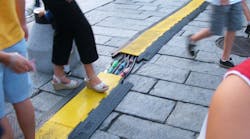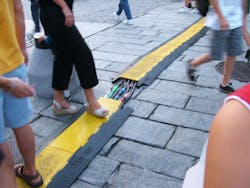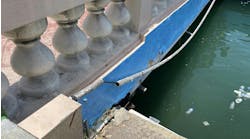Hint: Look out below!
Scroll Down to See the Answer
These unsuspecting pedestrians have no idea they’re walking over some temporary feeder cables installed to provide power for the street fair. For the most part, these cables are protected by the mats that have been placed over them, which helps minimize tripping hazards and provide some degree of separation from unqualified people. Unfortunately, the installers did not stagger the matt connectors. The result is the exposure of unguarded cables. This is a violation of Sec. 525.20(E). Laying these single conductor cables on the ground may seem like a violation of Sec. 590.4(J), which prohibits temporary feeder cables or cords from being installed in this manner. However, because this wiring is for a fair, Sec. 525.3(A) clarifies that where the Code rules for other Articles differ from the rules in Art. 525, the requirements found in Art. 525 shall apply to portable wiring. For the most part, these accessible cables comply with Sec. 525.20(G) since the protective matting does not constitute a greater tripping hazard than the cables themselves. The exposed connectors do need to be addressed though.





